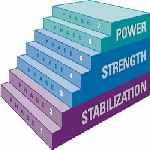In weight training, a periodization workout program is the practice of varying the training regimen at regular intervals to bring about optimal results for the trainee. Proven benefits of a periodization workout program include improved muscular endurance, strength and power, enhanced motor performance, and increased muscle mass. A periodization workout program works for short training durations, like weeks or months, as well as long periods of time like years, or the length of an athlete’s career. The cycles are broken up into a:
Macrocycle
A macrocycle refers to an annual plan that works towards peaking for the goal competition of the year. There are three phases in the macrocycle: preparation, competitive, and transition. The entire preparation phase should be around 2/3rds to 3/4ths of the macrocycle.The preparation phase is further broken up into general and specific preparation of which general preparation takes over half. An example of general preparation would be building an aerobic base for an endurance athlete such as running on a treadmill and learning any rules or regulations that would be required such as proper swimming stroke as not to be disqualified. An example of specific preparation would be to work on the proper form to be more efficient and to work more on the final format of the sport, which is to move from the treadmill to the pavement.
The competitive phase can be several competitions, but they lead up to the main competition with specific tests. Testing might include any of the following: performance level, new shoes or gear, a new race tactic might be employed, pre-race meals, ways to reduce anxiety before a race, or the length needed for the taper. When the pre-competitions are of a higher priority there is a definite taper stage while lower priority might simply be integrated in as training. The competitive phase ends with the taper an d the competition.
d the competition.
The transition phase is important for psychological reasons, a year of training means a vacation is in order. A typical weekend warrior might take three months while a professional athlete might take as little as two weeks.
Mesocycle
A mesocycle represents a phase of training with duration of between 2 – 8 weeks or microcycles. During the preparatory phase, a mesocycle commonly consists of 4 – 6 micro-cycles, while during the competitive phase it will usually consist of 2 – 4 micro-cycles depending on the competition’s calendar.
The goal of the planner is to fit the mesocyles id is to make sure the body peaks for the high priority competitions by improving each cycle along the way.
Microcycle
A microcycle is typically a week because of the difficulty in developing a training plan that does not align itself with the weekly calendar. Each microcycle is planned based on where it is in the overall macrocycle.
By incorporating periodization workout programs into his/her training regimen, an athlete can pre-arrange their peak performance for a specific point in time, like a major fitness competition. The same process can be applied with equal success by an amateur athlete or fitness trainee. The fact is, periodization workout programs will help you achieve maximal results in the shortest amount of time.
Numerous variables can be adjusted to optimize an exercise program:
• number of different specific exercises
• number of sets per exercise
• number of reps per set
• types of exercises
• rest periods between sets
• level of resistance
• type and tempo of muscle movement
• number of training sessions per week
With regard to these variables, it is volume and intensity, specifically, that are adjusted in a periodization workout program.
Intensity refers to the level of difficulty involved in performing each activity (i.e., how heavy you lift); volume refers to the number exercises, sets, and reps performed during a single session. These variables are mutually conflicting, in that the muscle only has so much strength and endurance, and takes time to recover. As a result, increasing volume by any significant amount necessitates decreasing the intensity, and vice-versa.











Very clear explanation of periodization, and very clear on the benefits of periodizing.
Amir
I’m aware of the periodization programs. They’re typically used by athletes to prepare for competition. Do you think it can be just as useful for a newbie?
everyone should be doing periodization programs. it’s how you get someone to their goals effectively.